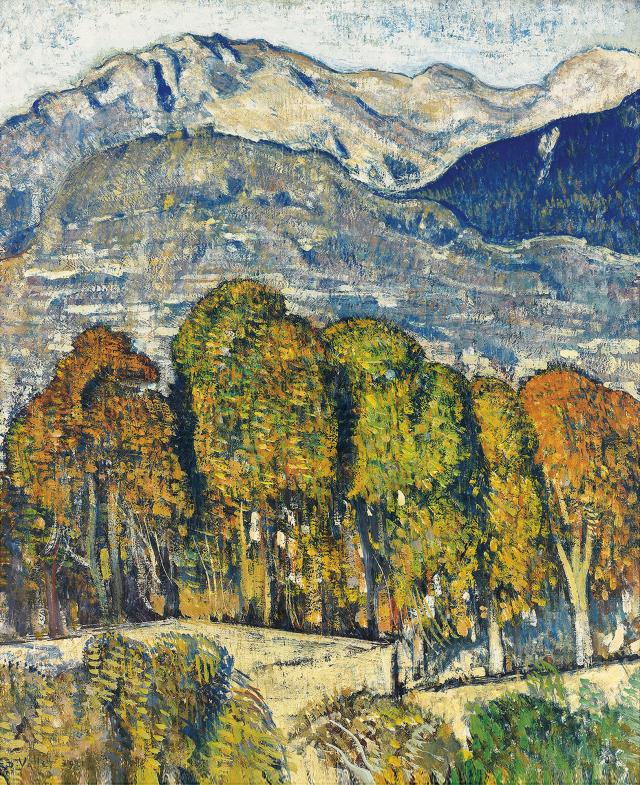When Édouard Vallet fell in love with the mountains, valleys and inhabitants of Valais, he immediately began transcribing the canton’s landscapes on canvas. Starting in 1908, the region became almost the sole pictorial and iconographic influence on his work. The Genevan artist never painted high peaks like the Cervin or Monte Rosa, but rather tackled the Alps around Vercorin, near Savièse, in the Rhone valley, or in Riod.
In November 1920, he settled with his family in Sion, where he intended to stay for several years and “paint there things I’ve been thinking about for a long time”. Trained in Barthélemy Menn’s studios, Vallet was quite capable of examining his subject with care and faithfully rendering it. But he also knew how to distance himself from it in order to distil its essence and transfigure it in paint.
With Marronniers-automne (Chestnut Trees-Autumn), he describes a view of the Montorge hills as observed from the plain of the Rhone valley. But beyond the subject itself, Vallet expresses colours, a texture and shapes. Édmond Bille, a native of Neuchâtel, wrote in this regard, “One wonders if Vallet’s Valais exists outside the heart and mind of the painter”. The picture proves to be first and foremost a painting before being a landscape. The earth tones of the palette, the thick, matt paint, the different pictorial layers are characteristic of the artist. His dense composition points up a superimposition of horizontal pictorial planes in a succession of compact volumes in which depth of any sort is dismissed. Neither atmospheric perspective, nor vanishing point opens the horizon. Emphasis is placed on the contrast between the speckled foliage of the foreground and the mineral look of the rocks in the background. The effective framing further reinforces the monumental aspect of this landscape.
Like Ferdinand Hodler, whom he admired, Vallet was interested in the mountain’s plastic qualities, notably its texture. Shunning unnecessary picturesque details, he suggests forms with heightened outlines and plain, sometimes sombre hues, to transcribe the impression made by this autumn atmosphere.
In November 1920, he settled with his family in Sion, where he intended to stay for several years and “paint there things I’ve been thinking about for a long time”. Trained in Barthélemy Menn’s studios, Vallet was quite capable of examining his subject with care and faithfully rendering it. But he also knew how to distance himself from it in order to distil its essence and transfigure it in paint.
With Marronniers-automne (Chestnut Trees-Autumn), he describes a view of the Montorge hills as observed from the plain of the Rhone valley. But beyond the subject itself, Vallet expresses colours, a texture and shapes. Édmond Bille, a native of Neuchâtel, wrote in this regard, “One wonders if Vallet’s Valais exists outside the heart and mind of the painter”. The picture proves to be first and foremost a painting before being a landscape. The earth tones of the palette, the thick, matt paint, the different pictorial layers are characteristic of the artist. His dense composition points up a superimposition of horizontal pictorial planes in a succession of compact volumes in which depth of any sort is dismissed. Neither atmospheric perspective, nor vanishing point opens the horizon. Emphasis is placed on the contrast between the speckled foliage of the foreground and the mineral look of the rocks in the background. The effective framing further reinforces the monumental aspect of this landscape.
Like Ferdinand Hodler, whom he admired, Vallet was interested in the mountain’s plastic qualities, notably its texture. Shunning unnecessary picturesque details, he suggests forms with heightened outlines and plain, sometimes sombre hues, to transcribe the impression made by this autumn atmosphere.
